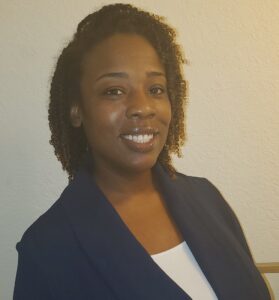
Choose Your Language:
Posted by: The Sumaira Foundation in NMO, Voices of NMO
 Tiffany was a military brat with both of her parents serving in the Navy, so joining up herself seemed the obvious choice for her. She enlisted in 2006 and met her husband on board a Navy ship in 2009. It was where she was meant to be.
Tiffany was a military brat with both of her parents serving in the Navy, so joining up herself seemed the obvious choice for her. She enlisted in 2006 and met her husband on board a Navy ship in 2009. It was where she was meant to be.
Tiffany was stationed in Suffolk, Virginia in January 2015. She woke up one day and felt off balance and figured she had pinched a nerve. Throughout the next week, her right leg grew weaker, and she noticed sensation changes in her left leg. Hot water felt warm and cold water burned. At the urging of her family, Tiffany took herself to the Naval Medical Center Portsmouth, where she was quickly diagnosed with NMO. With hindsight she realizes she was lucky to receive an accurate diagnosis so quickly as often, NMO is misdiagnosed.
In shock, Tiffany’s smile was frozen on her face as the neurologist gave her the news. He told her that her diagnosis was not funny. He started her on a five-day course of Solumedrol.
Later, Tiffany learned that her AQP4 antibody titer was very high, and that she had oligoclonal bands in her spinal fluid, which are common in patients with multiple sclerosis, but rare in NMO.
When she left the hospital, Tiffany’s right leg was completely paralyzed. She could move her left leg, but she couldn’t feel it. She wore a leg brace and used a walker.
The Navy provided for a physical therapist to visit Tiffany at home daily for six weeks. She improved a little bit each day, starting with her toes and moving up, so that two months later, Tiffany could walk normally. Still, her right leg tingled and burned.
Tiffany started taking Cellcept but did not always take it as prescribed. And almost two years after her initial attack, she stopped taking it altogether. So, it wasn’t really all that surprising when Tiffany relapsed in March, 2017. It started with a desperate urge to pee. When home, she noticed that again, her sensations were abnormal.
At that time, her husband was away on deployment, and she had two young children at home. Tiffany waited until the next morning, when she could bring the kids to a babysitter, before going to the hospital. The same neurologist she had seen for her first attack ordered an MRI and started her on Solumedrol the next day. He also changed her prescription to Rituximab.
With this attack, Tiffany’s left leg became paralyzed, though not completely. Though she has recovered for the most part, she still suffers with the tingling in the fingers of her right hand that started during this relapse.
Due to NMO, Tiffany was medically retired from the Navy in 2016, but it was not an easy road.
For this reason, NMO must be analogously rated to another disorder that is in the VASRD. Tiffany learned there were severe discrepancies in the rating received for individuals with NMO. Two other NMO veterans’ analogous ratings were MS and Lupus. Tiffany’s initial analogous rating was Syringomyelia but got changed to simply transverse myelitis. Being rated appropriately is important because the percentage for individuals going through medical boards will determine if a veteran is medically retired, meaning full benefits, or just being separated. Tiffany’s new rating for transverse myelitis meant she would be medically separated instead of retired. Tiffany decided to fight this.
Luckily for her, she found Dr. Stacey Clardy (Salt Lake City Veterans Hospital, University of Utah, and a member of TSF’s medical advisory board) who, along with several other doctors, went to bat for veterans with NMO, and requested that NMO be given an appropriate rating. Tiffany was able to get her rating corrected resulting in a medical retirement and ability to retain medical benefits. NMO is still not in the VASRD though updates from Dr. Clardy show changes are still in the pipeline.
Tiffany had been all Navy all the time, from her childhood through her marriage. NMO forced her out. In retrospect, Tiffany appreciates the gift this disease gave her. She loved the Navy and what it provided, but she has realized that the Navy was preventing her from reaching her potential. In the Navy, her work was circumscribed – limited due to duty stations and rank. Now a civilian, she couldn’t be happier, working as a government contractor with great pay and promotion opportunities that are not tied to strict timelines and requirements like in the Navy. Her husband, too, left the Navy to work in supply-chain logistics.
Today, Tiffany lives a full, fulfilling and happy life. Her husband, she says, was exceptional throughout the worst days of her disease. He was extraordinarily protective. He was perfect.Today, they have great jobs. Their children are school age and doing great. Tiffany doesn’t much think about NMO, as it hardly impacts her life today.
Like so many patients new to a disease, when Tiffany was first diagnosed, she went online and found that she might have only five years to live. She was partially paralyzed and otherwise in pain. She wondered if sympathy killing wouldn’t be the best thing for her.
Take what you read online with a grain of salt. The information out there is not necessarily true.
As told to Gabriela Romanow in September 2021